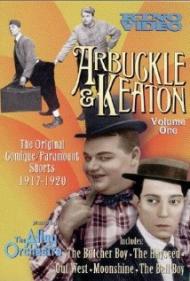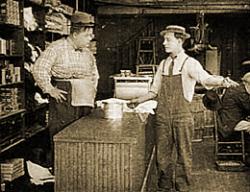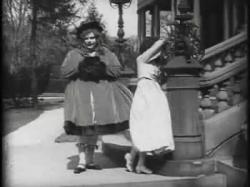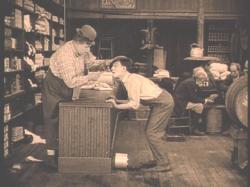Movie Review
The Butcher Boy

US Release Date: 04-23-1917
Directed by: Roscoe (Fatty) Arbuckle
Starring▸▾
- Roscoe (Fatty) Arbuckle, as
- Fatty
- Buster Keaton, as
- Buster
- Al St. John, as
- Slim Snavely
- Josephine Stevens as
- Amanda
![3 star[s] out of 4](http://www.threemoviebuffs.com/static/images/global/featured_gold_stars.png)
![3 star[s] out of 4](http://www.threemoviebuffs.com/static/images/global/featured_gold_stars.png)

Roscoe Arbuckle and Buster Keaton in The Butcher Boy.
The Butcher Boy is first and foremost an important film because it is the screen debut of the great Buster Keaton. Arbuckle took notice of Keaton when Keaton was working in his family's vaudeville act. Arbuckle had recently left Mack Sennett's Keyston films and invited Keaton to work with him.
Arbuckle was like many of the great film comedians in that he often wrote and directed his movies. In The Butcher Boy we see typical Arbuckle visuals. He often liked to just have the camera on him as he went about doing little antics. Here the movie opens with Fatty cutting meat at a general store. He flips the knife and absent mindedly leans on the scales when he weighs the meat. Also working at the store is Slim who, along with Fatty, has an eye for another co-worker, Amanda.
Keaton plays a customer and a co-hort of Slims. Keaton walks into the store and the movie really starts to take of. From sticky molasses to bags of flours exploding in people's faces, the store breaks out into an all out war zone. Amanda is blamed for inciting it and is sent to a girl's boarding school.
Fatty and Slim each go drag and sneak into the school. Buster gets involved as well and the school soon becomes a manic chase and fight involving a dog an old woman spanking Arbuckle. The final scene of this short is great as Arbuckle and Amanda head off to a parson to get married. After remembering that he is still drag, Arbuckle just smiles at the camera and they skip off to get married.
This short film was written and directed by Arbuckle. I am sure that many filming techniques had yet to be perfected but some of Arbuckle's direction is just plain amateurish. In several scenes you see plenty of floor but not the top of Arbuckle's head. Even if the camera didn't have adjustable leg heights they could have at least stood the camera on something.
Although not a classic due to it's content, it is a major piece of film history just watching Keaton make his first amazing pratfalls. Watch the scene where he gets hit in the face with a bag of flour. It looks just as if it knocked him off his feet. Then look at John getting hit a few seconds later. He pauses slightly before reacting to the hit. It's a small error but it demonstrates just how spot on Keaton was.

Fatty Arbuckle as Candy and Josephine Stevens as Amanda.
Fatty Arbuckle’s status as a movie star never recovered from his career ending scandal. Even today his name rarely enters the conversation when discussing the great silent screen comics. Chaplin, Keaton and Lloyd are revered above everyone else and if a fourth name comes up it is usually the baby faced Harry Langdon. Arbuckle was much funnier than Langdon and he was the first one of them all to be a famous star. In fact he helped the careers of Chaplin and, especially, Keaton.
Thank god his movies survive to keep his legacy alive for those that seek his work. He was so natural and effortless in front of the camera. His actions never seem rehearsed. He is certainly not the best butcher in the world. He is not exactly sanitary, even smoking a hand rolled cigarette over his meat counter.
Keaton, a very young looking 21 at the time, is a real mischief maker in his supporting role. The interaction between them when Keaton’s foot gets stuck to the floor with molasses and Arbuckle pours hot water on it to loosen it reminded me of Laurel and Hardy. I laughed when Keaton joined the grey beard’s checkers game uninvited. Those old codgers probably saw action in the Civil War.
Of course Arbuckle’s drag name would be Candy! In the scene outside of the boarding school the camera crops off the tops of Arbuckle and the teacher’s heads as Eric mentioned. It is either an unusual bit of sloppiness on Arbuckle’s part or it was an artistic decision meant to show how tall this “girl” is.
Eric mentioned the superiority of Keaton’s pratfall over St. Johns. Arbuckle, likewise, is a far better comic. His “girl” is much funnier and more believable than St. John’s. The way he makes a demure face and skips down the hall is hilarious. In both cases it is the difference between everyday talent and comic genius.
Although The Butcher Boy will be forever remembered as Buster Keaton’s movie debut it stands on its own. It offers a masters class in slapstick.

Fatty Arbuckle and Buster Keaton in The Butcher Boy.
This film might be of historical significance because of Keaton's first appearance, but judged simply on its own merits, it's a bit of a hit and miss affair. There are some frantic funny bits, but other parts feel like old shtick that was done a million times in these shorts.
Although it's all connected, this is really two shorts shoved together into one. You could separate it into two halves, with the first being the bit in the store, which is the funnier half, and the bit in the boarding school, which isn't quite as funny.
The part at the boarding school also left me a bit puzzled concerning ages. Amanda is old enough to work in a store and get married, but she's still young enough to attend a boarding school? And when Fatty dresses up like a girl, he dresses in a little girl's dress and wears his hair in curls, behaving as if he's a young child. So how old is Amanda?
Concerning the poorly cropped frames, I think there are several possibilities. One, given that they had no onset playback capabilities in those days, it's extremely possible that no one even noticed how poorly the shots were set up until the film was developed and I doubt reshoots were very common in those days. The other possibility is that there was something in the top of the frame, perhaps Fatty's wig was noticeably askew in shot and so rather than reshooting, they just cropped the frame to keep the scenes usable.
Fatty did have screen presence, but in the few shorts of his that I've seen, while he is amusing, he never builds any empathy between his character and the audience.He's funny, but I never particularly care all that much about what happens to him. Still, it is a pity that his pioneering work has been so overshadowed by scandal.
Photos © Copyright Paramount Pictures (1917)
